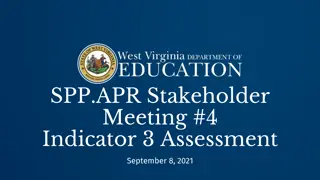Enhancing Algorithmic Team Formation Through Stakeholder Engagement
Integrating stakeholder voices is crucial in algorithmic team formation to ensure a positive team experience, quality outcomes, and high performance. This research explores learner-centered approaches and considers various team formation methods, highlighting their strengths and weaknesses in educational settings.
Download Presentation

Please find below an Image/Link to download the presentation.
The content on the website is provided AS IS for your information and personal use only. It may not be sold, licensed, or shared on other websites without obtaining consent from the author.If you encounter any issues during the download, it is possible that the publisher has removed the file from their server.
You are allowed to download the files provided on this website for personal or commercial use, subject to the condition that they are used lawfully. All files are the property of their respective owners.
The content on the website is provided AS IS for your information and personal use only. It may not be sold, licensed, or shared on other websites without obtaining consent from the author.
E N D
Presentation Transcript
LIFT: Integrating Stakeholder Voices into Algorithmic Team Formation Emily M. Hastings ehstngs2@illinois.edu March 3, 2021
Introduction What is HCI? Overview My research LIFT 2
Who Am I? Galesburg native Graduated from Knox in 2016 Major: Computer Science Minor: Renaissance/Medieval Studies (self-designed) CS TA and research assistant Costume Shop Currently 5th year PhD student at University of Illinois Human-computer interaction 3
Humancomputer interaction (HCI) studies the design and use of computer technology, focused on the interfaces between people (users) and computers. Researchers in the field of HCI observe the ways in which humans interact with computers and design technologies that let humans interact with computers in novel ways. (Wikipedia) 4
Human-Computer Interaction Multidisciplinary Computer science Psychology Cognitive Science Design Human factors Venues ACM Conference on Human Factors in Computing Systems (CHI) ACM Conference on Computer Supported Cooperative Work (CSCW) Many others 5
Learner-Centered Algorithmic Team Formation 6
Vision Every student can: Have a positive team experience Learn and contribute to a quality team outcome Work on a high-performing team Bring together CS, the learning sciences, and other fields to design, deploy, and study a new genre of algorithmic team formation tool that more closely considers the needs and experiences of learners 7
How should instructors form teams in their courses? 8
2 Possibilities Self-selection Random assignment Strengths Easy to implement Some students prefer to select their own team Weaknesses Students may struggle to find a team to join Lack of skill diversity 9
Criteria-based Team Formation Strategically select team members to achieve certain compositions Skill diversity (e.g., Brickell et al. 1994, Horwitz and Horwitz 2007) Balanced personality types (e.g., Lykourentzou et al. 2016) Balanced genders (e.g., Jehn, Northcraft, and Neale 1999) Many more 10
Drawback/Opportunity #1 Tools assume that the instructor should configure the inputs to the algorithm Students have little input Potential benefits of increased knowledge and control Prevent viewing the algorithm as a black box (Blowers 2003) Increased satisfaction and acceptance (Vaccaro et al. 2018, Cramer et al. 2008, Kizilcec 2016, Lee et al. 2015) Greater ownership of group problems (Mello 1993) 12
Drawback/Opportunity #2 Tools often rely on data self-reported by students Concerns about accuracy Interface can cause confusion (Jahanbakhsh 2017) Difficulties with self-assessment (Mabe & West 1982, Falchikov & Boud 1989) Possible gaming behavior (Jahanbakhsh 2017, Alamri 2018, Hastings 2020) 13
Drawback/Opportunity #3 Instructors lack support and may not be using tools effectively May not be familiar with the most recent team composition literature (Jahanbakhsh 2017) Desire more guidance (Jahanbakhsh 2017) In practice, tend to select complex combinations of criteria that can be hard to satisfy and may not have the same benefits as more focused selections (Hastings 2018) 14
My Research Opportunity #1: LIFT Workflow Learnersourcing workflow delegating the configuration of the team formation algorithm to students in the course where teams are formed (CHI 2020) Opportunity #2 Survey of student experiences with self-assessment (in progress) Collaborative self-assessment interface (proposed) Opportunity #3 Survey of instructor practices configuring algorithms (in submission) Configuration interface augmented with student input (proposed) 15
LIFT: Integrating Stakeholder Voices into Algorithmic Team Formation Emily M. Hastings, Albatool Alamri, Andrew Kuznetsov, Christine Pisarczyk, Karrie Karahalios, Darko Marinov, Brian P. Bailey
Experimental Design Mixed-methods between participants experiment (N=289) Interviews with 18 students and 6 instructors Condition 1: Learner (LIFT) Condition 2: Instructor (Control) 18
Measures Project Grades Perceived Performance Satisfaction with Team Assignment Satisfaction with Team Formation Process Recommendation to Repeat Approach Perceived Agency Importance of Input 19
Results 20
RQ1 RQ1: What team formation criteria do students select when given the chance? How do student and instructor choices differ? 21
RQ1: Student Criteria Choices 75 criteria discussed in total, 48 (64%) newly-proposed E.g., Organizational style 3 broad categories: Team management (e.g., Leadership role, Teamwork experience) Academics (e.g., GPA, Software skills) Identity (e.g., Gender, Personality type) Voting phase eliminated all less serious criteria Most popular: scheduling, skills, work habits Least popular: aspects of past and identity not under present control 22
Instructor Criteria Choices All instructor criteria selected from tool Prioritized learning and long-term success over minimizing present conflict High achievers may need to be in teams with other high achievers so that they have this sort of conflict...[and] can work through a disagreement with another student. I think it is a wonderful opportunity for growth. (I2) 23
RQ2: RQ2: How do students perceive their agency when they are allowed to have input into the team formation process? 24
RQ2: Student Perceptions of Agency Students found it important to have a voice (median 6.0) Median agency score in Learner condition was higher (median 5.0 vs 4.0), but not statistically significant (Wald 2(1)=3.05, B= 0.77, p=0.08) Possible explanation: participation vs. choice 25
RQ2: Student Perceptions of Agency Strengths: LIFT can provide insight to instructors who are disconnected from the student team experience (S=10) LIFT contributed to increased sense of ownership (S=5) Weaknesses: Students are not experts on what makes a good team (S=6) Instructors more familiar with the course and what skills will be necessary (S=8) Concerns of gaming (S=5) 26
RQ3: RQ3: How does allowing students to select criteria affect their team performance, satisfaction, and other course experiences compared to having instructors select criteria? 27
RQ3: Effects of Criteria Selector on Outcomes High across conditions No significant effect of criteria selector Potential explanations: Specifics of criteria configuration may not be most important factor in outcomes Expectation effect (Hastings et al. 2018) 28
RQ4: RQ4: How do instructors perceive transferring agency in the team formation process to students, and what do they learn about student preferences? 29
RQ4: Instructor Perceptions Found student choices reasonable overall, including confirming personal doubts: Was GPA on? See, GPA is not even on there! Gosh, see that! The students are smarter than me See, I guess I wish [I had] heard or learned this earlier. (I2) Some doubts about irrelevant criteria, gaming concerns, excluding important criteria: That's a hard question... there's a lot of literature on gender and achievements and race, like we should really pay attention to that, but then again I don't know. I'm not the students, and I don't know what their biases are, if they have biases... all I know is literature so... I don't know. I don't know if I trust that much that they know themselves so well. (I3) 30
RQ4: Instructor Perceptions Three instructors would adopt LIFT as-is, a fourth would integrate student criteria into his own configuration Responsibility, motivation, sense of ownership Remaining two instructors were reluctant to adopt due to key exclusions or large course sizes 31
Implications for Instructors Possible to incorporate student input into algorithmic team formation without adversely affecting grades or team experiences Alternatives to full LIFT workflow: Adopt simplified version of LIFT for convenience E.g., vote only on weights Integrate student- and instructor-chosen criteria in a single configuration Protect voices of minority students 32
Implications for Tool Designers Incorporate features to delegate algorithmic control to students E.g., surveys, discussion forums Include elements of LIFT workflow directly in the tool rather than relying on external platforms Precautions against possible manipulative behavior E.g., reduce reliance on self-reported data, collect survey responses before revealing weights 33
Contributions Deeper empirical understanding of the effectiveness of leveraging learners' collective choices to shape the algorithmic team formation process Learner-centered workflow instructors can deploy to tap into the criteria that matter most to students in their specific courses Practical implications for how designers of team formation tools can give stakeholders more control over the algorithmic team formation process Thank you to our participants! 34
Questions? ehstngs2@illinois.edu emhastings.github.io 35























